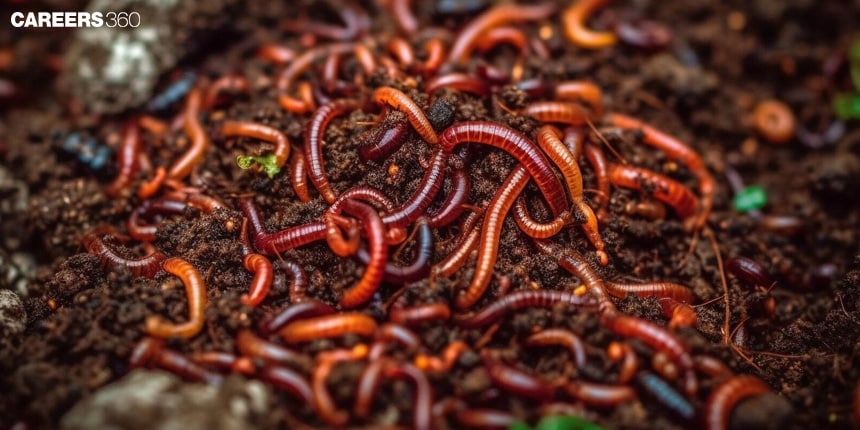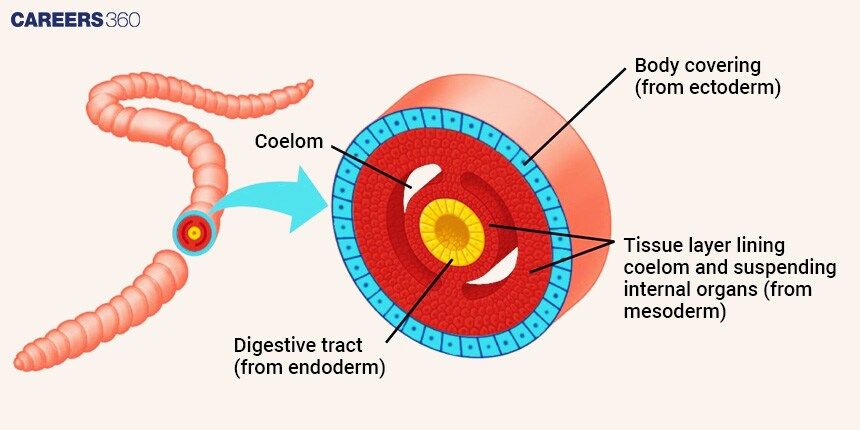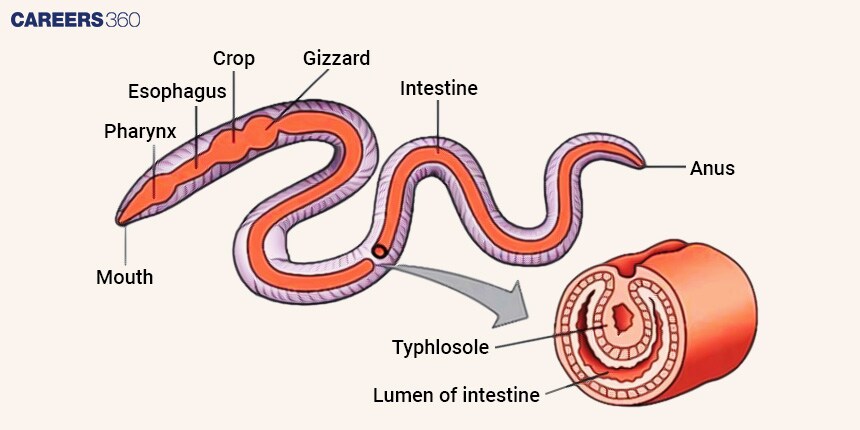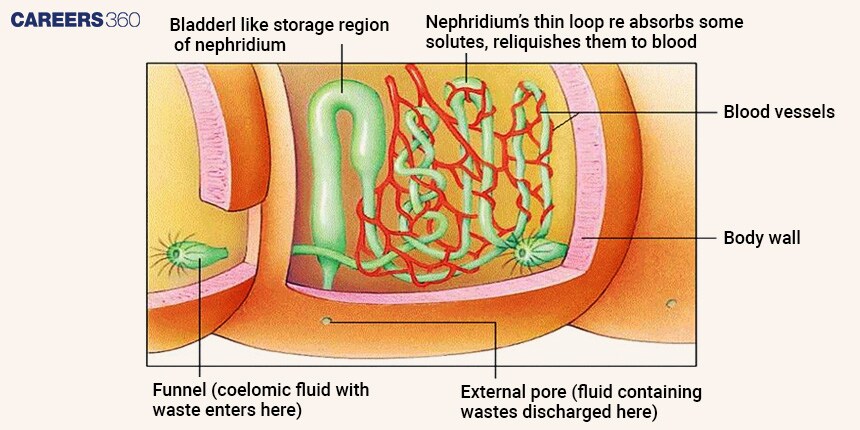Annelida - Overview, Types, Examples, Anatomy and Physiology of Annelids
Phylum Annelida is a group of segmented worms, such as earthworms and leeches, with bodies divided into segments. This topic is from the class 11 chapter Animal Kingdom in Biology. This article includes Annelida characteristics, classification, examples and diagrams helpful for the students preparing for competitive exams like NEET, AIIMS Nursing etc.
NEET 2025: Mock Test Series | Syllabus | High Scoring Topics | PYQs
NEET Important PYQ's Subject wise: Physics | Chemistry | Biology
New: Meet Careers360 B.Tech/NEET Experts in your City | Book your Seat now
- Definition of Phylum Annelida
- General Characteristics of Annelids
- Examples of Annelida
- Classification of Annelids
- Anatomy and Physiology of Annelids
- Ecological Importance of Annelida
- Recommended Video on Annelida

Definition of Phylum Annelida
Annelida consists of a phylum of segmented worms characterised by the segmented body and coelomic cavities that hold earthworms, leeches, and polychaetes. The Annelids are an important group studied in Zoology and are associated with key ecological, economic, and medicinal roles.
Also Read:
General Characteristics of Annelids
Annelida's characteristics are given below:
The term 'Annelida' is derived from the Latin term annulus, which implies small rings. This phylum contains the animals that are also called 'Ringworms'.
The Annelids possess a truly segmented body because such segments or metameres are visible on the outer periphery as annuli and internally as septation.
Segmentation allows for movement and survival with greater possibilities by providing redundancy.
They are triploblastic and bilaterally symmetrical.
They have a true coelom, they are coelomate. The mesoderm lines the cavity on both sides.
Examples are Nereis, Pheretima (Earthworm) and Hirudinaria (Blood-sucking leech).
The outermost layer of the epidermis is provided with an acellular cuticle.
There are two layers of muscles, circular ones and longitudinal ones.
Hair-like projections come out through the epidermis called setae/chaetae.
These setae are found in every segment.
Examples of Annelida
Some common examples of Annelida are:
- Earthworms (Pheretima), are commonly found in terrestrial environments.
- Leeches (Hirudinaria), are often found in freshwater.
- Polychaetes (Nereis), inhabit marine environments.
Annelida Structure Diagram
The diagram given below shows the body plan of Annelida.

Classification of Annelids
The phylum Annelida is classified into different groups which are described below:
Polychaeta
Oligochaeta
Hirudinea
Archiannelida
Polychaeta
Their body is elongated and can be divided into many segments.
They have a fully developed nervous system and have a closed blood circulation system.
These living creatures have coelom present in their body so they are true coelomates and they are worlds with bilaterally symmetrical bodies.
The fertilization happens in these animals, externally.
They are mostly found in marine environments like ponds, rivers, etc.
They contain fin-like appendages that are known as parapodia and they are also hermaphrodites.
The living organisms that belong to this group have a lack of clitellum and they are dioecious.
Some animals of this group are Nereis, Syllis, etc.
Oligochaeta
This group includes those animals which are mostly found in freshwater and are also terrestrial organisms.
In these animals, the head, eyes and tentacles are not different. These animals are also hermaphrodites but the cross-fertilization does not take place in them.
The body of animals of this group is segmented metamerically.
The process of fertilization occurs in an external type and the cocoon is formed during the fertilization.
In these animals, parapodia are not present whereas clitellum is present in these animals.
These animals do not exhibit larval stage and the development during fertilization takes place in the cocoons.
Pheretima and Tubifex are some examples of this group of animals.
Hirudinea
The animals of the Hirudinea group are generally found in freshwater. Some of them are marine, parasitic, and terrestrial
The body of animals in this group is segmented and are monoecious.
There is not any larva stage present in the development cycle of these organisms.
In this type of animal, the process of fertilization takes place internally and these animals are hermaphrodites.
The mouth of these organisms is situated in the anterior sucker and the anus is situated dorsally in the exterior sucker in the body.
The organisms of this group lay eggs in their cocoons.
Hirudinaria is an example of the Hirudinea group.
Archiannelida
The body of animals of the Archiannelida group grows long without the setae and parapodia.
These animals are only present in the marine environment like various water bodies.
These living organisms are unisexual and these organisms are hermaphrodites.
There are tentacles present on the prostomium of the organisms of this group.
Examples of animals in this group are Dinophilus and Protodrilus.
Anatomy and Physiology of Annelids
In general, annelids have a definite head region, or prostomium, a segmented body, and in many species, bristle-like setae that move and anchor them.
Digestion in Annelids
They have a complete digestive system that includes the pharynx, gizzard, stomach, and long intestine.
The first segment is called peristomium, and it contains a buccal cavity.
It covers the prostomium at the buccal cavity.
Annelids may be filter feeders or predators.
Diagram of Annelids Body Parts
The diagram shows the internal body parts of the phylum Annelids.

Excretion in Annelida
The excretion is carried out by metanephridia.
Annelids are ammonotelic animals, they excrete ammonia as the nitrogenous waste.
Diagram showing the working of metanephridia in Earthworms:

Nervous System and Sense Organs in Annelida
The annelids have a highly developed nervous system.
They possess a nerve ring made up of fused ganglia around the pharynx. They have a ventral nerve cord.
The nerve cord displays the branches of ganglia in each segment.
Osphradia, tentacles, chemical receptors, statocysts, and eye-spots are present in marine free.
Circulatory System in Annelida
The annelids have a closed blood system, where the blood flows through vessels. The ventral and dorsal set of blood vessels runs parallel to the alimentary canal. These ventral and dorsal blood vessels have branches that supply every segment by transverse loops.
Reproduction in Annelida
Annelids like earthworms and leeches are hermaphroditic with permanent gonads while polychaetes show seasonal gonads.
Many species of marine annelids have a trochophore larva that undergoes metamorphosis from a metatrochophore larva to an adult.
The key adaptation of annelids to survive and reproduce is their ability to regenerate lost segments.
Ecological Importance of Annelida
Annelids play a crucial role in the following;
- Nutrient Cycling: Earthworms improve soil fertility since they break down organic matter.
- Aquatic Ecosystems: Polychaetes are used as bait and fish food in aquaculture.
- Medicinal Uses: Leeches are helpful in reconstructive surgery.
Economic Importance of Annelida
Earthworms and leeches are important economically because they are applied in agriculture, medicine, and monitoring of the environment as bioindicators of soil and water quality.
- Annelids represent high economic and ecological significance. Polychaetes play an important role in fisheries and aquaculture as bait and fish feed.
- The medicinal leeches play a very important role in reconstructive surgery by improving blood circulation.
- The annelids, mostly oligochaetes, are also environmental indicators, indicating quality both in soil and aquatic environments and, therefore, very useful for environmental monitoring.
- Annelids are segmented worms showing impressive ecological, economic, and medical importance while displaying different forms and adaptations.
- Altogether, this research enables further investigation of annelid genetics, regenerative capacities, and ecosystem functions, which can become the basis of new biotechnological applications and strategies for conservation.
Read More:
| Phylum Platyhelminthes | Phylum Ctenophora |
| Phylum Cnidaria | Phylum Porifera |
| Phylum Arthropoda | Phylum Mollusca |
Recommended Video on Annelida
Frequently Asked Questions (FAQs)
The length of animals of the phylum Annelida differ from a fraction of an inch to greater than 20 feet or about 6 meters.
The term Annelida is derived from a Latin word Annulus and the meaning of this is 'little rings'.
The phylum Annelida is classified into four groups that are Polychaeta, Oligochaeta, Hirudinea and Archiannelida.
The width of the animals of the phylum Annelida may be more than 2.5 centimeters or about an inch when they are in contracted state.
There are more than 9000 species of Annelids present in the whole animal kingdom.
Some annelids are both sexual and asexual reproducers, while others have regeneration possibilities or independent larval stages—for instance, trochophore larvae.
Some annelids are both sexual and asexual reproducers, while others have regeneration possibilities or independent larval stages—for instance, trochophore larvae.
In particular, earthworms significantly enhance soil fertility and aeration by playing an important role in soil health and nutrient cycling.
In particular, earthworms significantly enhance soil fertility and aeration by playing an important role in soil health and nutrient cycling.
Polychaetes have many bristles—setae—and are mostly marine, whereas oligochaetes, which include earthworms, have few setae and are primarily terrestrial and freshwater in their habitat.
Polychaetes have many bristles—setae—and are mostly marine, whereas oligochaetes, which include earthworms, have few setae and are primarily terrestrial and freshwater in their habitat.
Also Read
29 Nov'24 12:52 PM
26 Nov'24 04:23 PM
26 Nov'24 04:19 PM